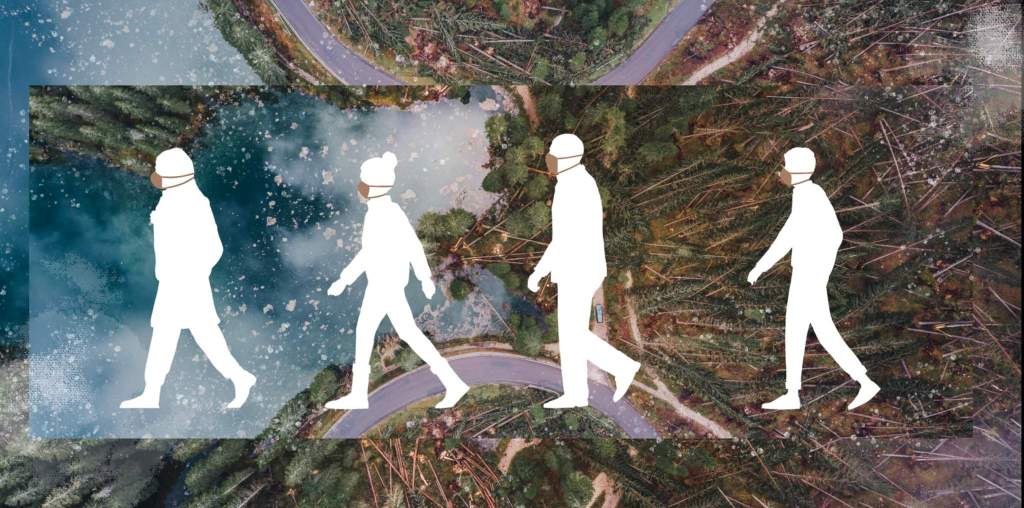Natural Disasters and Public Health in the COVID-19 Era

In the late winter and early spring of 2020, Iowa steeled itself against potential floods that threatened to further damage the state’s infrastructure. Extreme flooding the previous year turned Iowa’s levy system to “Swiss cheese,” said Joyce Flinn, Iowa’s homeland security and emergency management director, and the state was already deploying flood prevention equipment to guard against flooding predicted for the spring.
New floodwaters never materialized. But within weeks came other challenges, as the COVID-19 pandemic and tornadoes touched down across the state.
“Then it became a different focus of keeping an eye on potential flooding as well as responding to the COVID event,” Flinn said. “So, we had to think about how would we do that.”
Iowa has not been alone in combating natural disasters during the pandemic: Tornadoes and floodwaters swept through the Midwest, wildfires threatened dry Western states and a strong hurricane season was predicted for the Southeast. Paired with a pandemic, cascading natural disasters can create complicated response scenarios and heighten public health hazards. Although COVID-19 has created additional difficulties for disaster-prone regions, there are steps individuals and communities can take to minimize their risk in the event disasters strike during a pandemic.
What Public Health Problems Do Natural Disasters Create?
Fatalities that result directly from natural disasters are most often caused by trauma or drowning, whereas disease outbreaks stem from the secondary effects of disasters—not the disasters themselves.
Although different types of disasters result in unique damages, they often create similar conditions that allow disease to spread. The National Institutes of Health (NIH) reports risk factors that lead to the spread of disease after disasters can include infrastructure destruction, shelter loss, population displacement, stagnant or contaminated water, and food insecurity.
The most common communicable diseases that spread after natural disasters involve respiratory tract infections and diarrhea, usually as a result of poor sanitation and large groups being forced to gather in small spaces—meaning the spread of a virus like COVID-19 could become a concern. Vector-borne diseases—transmitted by other living organisms, such as infected animals or blood-sucking insects—can also become problematic if their carriers spread; natural disasters often set up the perfect environments for proliferation.
Long-Term Effects of Natural Disasters
Communities and individuals should consider how the lasting impacts of natural disasters could adversely affect public health, especially during a pandemic. Such effects could include:
- Collapse of health care facilities and systems
- Disrupted medical treatment or use of unprescribed medications
- Disrupted health surveillance and programs (e.g., immunizations and vector control)
- Food insecurity and inadequate nutrition
- Displaced populations—domestic and international
- Proliferation of vectors (e.g., mosquitoes and rodents)
- Unplanned and overcrowded shelters
- Contaminated water
- Poor sanitation and personal hygiene
- Low levels of immunity
How to Prepare for Natural Disasters During a Pandemic
Because pandemics can complicate the effects of and responses to natural disasters, individuals and families in disaster-prone regions should take additional precautions to protect their health if a disaster strikes. The following tips may help in the preparation process:
Start preparing early. Begin gathering supplies and planning an evacuation strategy before natural disasters become an immediate threat.
Make an emergency kit and an evacuation kit. Ensure your first-aid materials meet your family’s needs. An emergency kit should have enough supplies—including food, water, face masks, medicine and hand sanitizer—for two weeks.
Learn lifesaving skills. First-aid skills and CPR can be helpful to learn or review. Seek out remote or video training online if needed.
Assess your home’s utilities. Prepare for power outages. Preparation measures can include storing an extra propane tank to cook food or securing a generator.
Make an evacuation plan. Coordinate with friends and relatives to avoid potentially infected shelters. Try to limit the distance you travel and minimize contact on your route by wearing masks, using gloves and disinfecting after each stop you make. Plan what to do with your pets.
Stay connected to family and friends. Make hard copies of emergency contact information in the event of power or mobile network outages.
Protect yourself and others if you must go to a shelter. Follow guidelines from the Centers for Disease Control and Prevention and local officials to protect yourself, including wearing face coverings, using hand sanitizer and keeping your living area disinfected.
Listen to local guidance on evacuations. Download the FEMA and Red Cross mobile apps, and check websites including ready.gov and FEMA’s coronavirus response page for more information.
Why Do Diseases Spread After Natural Disasters?
Three types of risk factors within the “epidemiologic triad” influence disease transmission after disasters: the combination of the environment (external factors), the host (individual) affected and the agent (infectious organism) of a disease.
Which Factors Increase Your Risk of Disease After a Disaster?
These risk factors in the epidemiologic triad are among the elements that can contribute to communicable disease transmission in emergency situations, according to the CDC and World Health Organization.

Environment
Geology or climate
Loss of shelter or location of temporary housing
Overcrowding
Lack of clean water
Poor sanitation
More vector breeding
Lack of health care or delays in treatment

Host
Physical and psychological health
Low immunity or vaccination coverage
Malnutrition
Exposure to disease vectors
Poor personal hygiene
Underlying conditions

Agent
Presence of disease or vector in affected area
Ability to survive in an environment
Severity of disease
Ability to cause disease (pathogenicity)
Drug resistance
How Communities Can Prepare for Natural Disasters During a Pandemic
Risk assessment and epidemiology in post-disaster settings can help inform responses and control the spread of disease.
According to a Smithsonian Magazine article on public health effects of national disasters: “Using epidemiologic methods and study designs in post-disaster settings can help identify vulnerable populations, quantify deaths and injuries and determine how disasters have affected public health. It also can lead to better decision-making and use of resources.”
Another top priority community leaders should consider is how they will reestablish primary health care to minimize disease transmission. This may require a pivot from traditional delivery methods. In addition to having clean working conditions, health care workers and volunteers need to have sufficient medical equipment and any necessary training.
Flinn said partnerships between emergency managers, public health officials and first responders are critical to disaster response. Her team had previously established relationships with epidemiologists, who helped influence government operations and responses to the COVID-19 pandemic.
“Public health has a role in every kind of disaster,” Flinn said. “Whether it’s a flood that impacts wells, or they need to provide guidance to citizens on staying out of flood waters—or, for example, Zika virus or … Ebola a few years ago. There was always a role for public health.”
Even though not all disasters or public health crises can be predicted, there is one simple step individuals can take to prepare: stay informed.
“It’s important for people to just pay attention,” Flinn said. “Just be aware; pay attention to what’s going on.”
How Will COVID-19 Complicate Disaster Responses?
Displaced people are the most vulnerable to the novel coronavirus and the least able to combat the disease because of crowding and a lack of shelter, medical care and sanitation.
Factors that will increase the risk to populations affected by natural disasters and COVID-19 include:
- Crowded or infected shelters
- Uncertain supply chains for food and medical supplies
- Stressed health care systems
- Insufficient disaster response resources
Disaster Planning Considerations for Community Leaders During a Pandemic
The novel coronavirus pandemic is already changing the way communities plan for disaster responses. Emergency planners and public health officials should consider how responsive measures such as moving vulnerable populations, putting out consistent messaging and offering shelter might look different during a pandemic than under normal circumstances.
Evacuating individuals and families. Officials must consider how to evacuate people from a disaster zone while maintaining healthy practices like social distancing.
Creating safe shelters. Disaster zones will have to plan for additional shelter space,and shelters will have to implement measures to keep inhabitants safe. The Red Cross has new shelter guidelines, including screening people for illness and spacing cots 6 feet apart.
Securing recovery resources. As health and emergency resources are already strained, communities will need to get creative when it comes to recovery funding, stocking up on supplies and recruiting volunteers. For example, local officials in Mississippi are teaming up to procure personal protective equipment (PPE) for areas in need.
Communicating consistently. Public officials should plan to put out clear and consistent messaging around evacuating versus sheltering in place. Urging residents to evacuate could become difficult after stay-at-home orders have been implemented during the pandemic. Translating critical information to other languages can also be helpful for residents whose first language is not English.
Separating emergency operations centers (EOCs). If possible, designate separate response centers for different types of disasters. Officials in Iowa, for instance, dedicated their main EOC to responding to COVID-19, with an alternate center for natural disaster response.
Training first responders. First responders may not be trained to prepare for cascading disasters. Communities should assess training for first responders and implement training that prepares them to respond to multiple events.
Additional Resources
The following pages offer additional information about preparing for natural disasters and precautions to take during pandemics.
- CDC: Disaster Resources
- CDC: Infection Control After a Disaster
- CDC: Information for Disaster Evacuation Centers
- CDC: Overview of Disaster Epidemiology
- CDC: Preparing for Hurricanes During the COVID-19 Pandemic
- FEMA: Coronavirus (COVID-19) Response
- FEMA: Preparing for Hurricane Season During the COVID-19 Pandemic
- Public Health Emergency: Natural Disasters
- Ready.gov
- Red Cross: Preparing for Disaster During COVID-19
- Red Cross: Common Disasters Across the U.S.
- Red Cross: Make a First-Aid Kit
- SAMHSA: Disaster Distress Helpline
Published: July 2020
